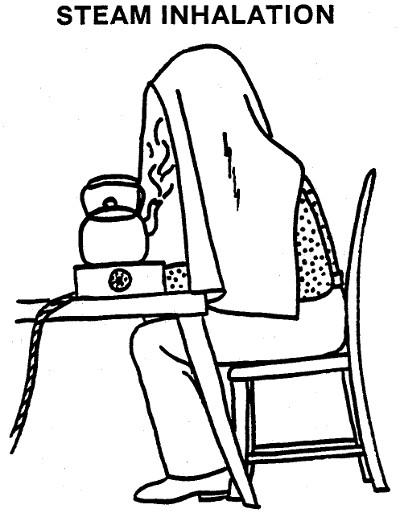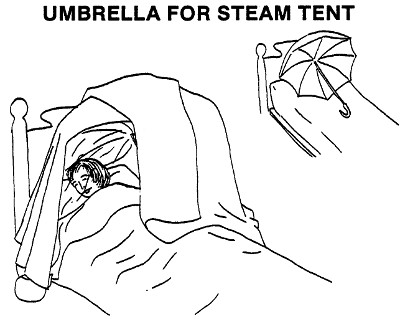Steam Inhalation


HYD
from Hydrothermic Remedies...
Warm moist air directed toward the mucous membranes of the upper respiratory tract will often help to loosen the dry cough or stuffiness which is commonly felt.
Effects:
- Relieve the chest and throat symptoms of colds and flu
Definition
Supplying of warm, moist air to congested mucous membranes.
Physiologic Effects
- To relieve inflammation and congestion of upper respiratory mucous membrane
- To relieve irritated throat by moistening the air
- To relieve spasmodic breathing
- To loosen secretions and stimulate discharge of mucous from the throat and lungs
- To relax muscles and relieve coughing
- To keep mucous membranes from excessive drying
Indications
- Coughing
- Nasal Congestion, Throat Congestion
- Dry throat, Throat Inflammation and Naso-Pharyngeal Irritation
- Spasmodic breathing in Croup
- Loosen dry or thick secretions
Contraindications or Cautions
- Extremely young children or the very aged who may not be able to respond to heat
Equipment
- Tea kettle with boiling water
- Newspaper cone - Newspaper rolled into a cone shape.
- Hot plate
- Electric rice cooker can be used instead of the above 3 items
- Medication, pine oil, eucalyptus, menthol (optional)
- Sheet
- Umbrella
Procedure
Important Considerations
- Check inhalation frequently
- Be careful not to burn patient
- Be extra careful when treating children
Preparation for Treatment
- Assemble equipment
- Make sure there are no drafts in the room and that it is warm.
Treatment
- Fill tea kettle with boiling water; add medication to water
- Carry to bedside and place on hot plate
- Cover spout with a cone made of rolled newspaper in order to carry steam directly to person's nose and mouth
OR
- Place a towel over the head and catch the stream with the towel.
- If the patient is in bed, use umbrella to make a tent, place umbrella at head of bed, just above the patient's head and drape a sheet over it, making sure the paper cone is under the 'tent'.
- Do not completely enclose the patient.
- Have patient breathe slowly and deeply
- Continue for 30 minutes to 1 hour at least 2-3 times per day
- For continuous inhalation, place tea kettle and hot plate on the floor without the paper cone. This will saturate the air of the entire room. Or use a vaporiser beside the bed.
Completion of Treatment
- Make sure patient is warm and dry
- Encourage patient to rest for at least 1/2 hour after treatment
This treatment may be given following other treatment such as Fomentation to the chest
Normally, air passing to the lungs during breathing courses through the nasal cavity where it is warmed and humidified since in the nose it is exposed to a large surface of warm, moist mucous membranes. Turbulence caused by the turbinates increases these effects. In the case of a cold, the nasal cavity becomes congested so that breathing has to be done largely through the mouth which does not warm and humidify the air as well. The dry, cold air irritates the passages and thus aggravates the inflammatory processes, which makes mucous in the air passages thick and even forms plugs. The mouth is constructed for food passage rather than for breathing. Steam inhalation treats these problems by humidifying and warming the air breathed.
JHK
from Dr JH Kellogg's Hydriatic Techniques...
10-15min hourly, mild temperature, soothing in acute conditions such as ...
10-15min hourly in chronic conditions as hot as the patient can bear by deeper breathes in
- Chronic Tonsillitis
- Throat Congestion
Face-bath 15min, iced towel to face 30sec to finish, 3X daily in
Face-bath 1min, Ice Compress to face 15sec, 10X in atony of nasopharynx
Face-bath 2-3min alternate with cold blast 30sec in
Rubbing cold blast in
- Inactive Skin of Debility until skin can react alone, daily decrease rubbing and increase air flow
Hydrotherapy Techniques:
Local Applications
Irrigations
- Applications to Mucous Passages
- Bladder Irrigation
- Cold Water Drinking
- Ear Irrigation
- Enemas
- Eye Irrigation
- Gargle
- Gastric Lavage
- Hot Water Drinking
- Intra-Uterine Irrigation
- Nasal Irrigation
- Psychrophore
- Rectal Irrigation
- Rectal Lavage
- Steam Inhalation
- Steam Jet
- Throat Irrigation
- Urethra Irrigation
- Vaginal Irrigation
- Water Emetic
- Water Drinking
